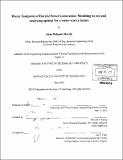Water footprint of electric power generation : modeling its use and analyzing options for a water-scarce future
Author(s)
Delgado Martín, Anna
DownloadFull printable version (22.51Mb)
Other Contributors
Massachusetts Institute of Technology. Technology and Policy Program.
Advisor
Howard J. Herzog.
Terms of use
Metadata
Show full item recordAbstract
The interdependency between water and energy, sometimes called the water-energy nexus, is growing in importance as demand for both water and energy increases. Energy is required for water treatment and supply, while virtually all processes for energy production require significant amounts of water. The water and energy nexus is a multifaceted issue. This thesis focuses on the water footprint of electricity generation, specifically on the water use at thermal power plants. Thermal power plants produce around 70% of the electricity in the US. These power plants require large quantities of water, primarily used for cooling. In the US, the thermoelectric power generation sector accounts for 40% of the total fresh water withdrawals every year. This has an impact both on the aquatic organisms and on the water resources of the region where the power plant is situated. In addition, water is becoming a scarce resource in many regions of the US, and the situation could worsen in the upcoming years. Therefore, it is important to understand the water footprint of the different electricity generation technologies in order to incorporate the information into the decision-making process and to choose the best options. Unfortunately, there is not a clear, generic model to estimate water use in power plants. Existing methods rely on data from direct surveys of power plant operators, which are often unreliable and incomplete, or from very detailed and plant specific models. This thesis offers a new framework to estimate the water use in power plants using a simple, generic model and focusing on the heat balance of the power plant. The model is used as a common analytical framework to evaluate the water requirements of different types of electricity generating power plants. The model is also used to identify the main drivers on water use in power plants and to explore the possible alternatives to mitigate water use by the power sector in the future. Since regulations and not price signals are usually the drivers of water-related power plant decisions, the presented model will also be very useful in policy analysis and policy decision making processes.
Description
Thesis (S.M. in Technology and Policy)-- Massachusetts Institute of Technology, Engineering Systems Division, Technology and Policy Program, 2012. Cataloged from PDF version of thesis. Includes bibliographical references (p. 113-117).
Date issued
2012Department
Massachusetts Institute of Technology. Engineering Systems Division; Technology and Policy ProgramPublisher
Massachusetts Institute of Technology
Keywords
Engineering Systems Division., Technology and Policy Program.